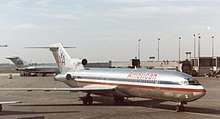2003 Angola 727 disappearance
 N844AA, the aircraft involved, in 1989 | |
| Incident | |
|---|---|
| Date | May 25, 2003 |
| Summary | Disappeared, theft, whereabouts unknown |
| Site |
Quatro de Fevereiro Airport, Luanda, Angola 08°51′30″S 13°13′52″E / 8.85833°S 13.23111°ECoordinates: 08°51′30″S 13°13′52″E / 8.85833°S 13.23111°E |
| Aircraft | |
| Aircraft type | Boeing 727-200 |
| Operator | Aerospace Sales & Leasing |
| Registration | N844AA |
| Occupants | 2 (Unconfirmed) |
On 25 May 2003, a Boeing 727-223, registered N844AA, was stolen at Quatro de Fevereiro Airport, Luanda, Angola.[1] Its disappearance prompted a worldwide search by the United States' Federal Bureau of Investigation (FBI) and Central Intelligence Agency (CIA). No trace of the aircraft has since been found.
Background
The aircraft involved was a Boeing 727-200 manufactured in 1975 and formerly operated by American Airlines who operated the aircraft for 25 years. Its last owner was reported to be Miami-based company Aerospace Sales & Leasing.[2] While on lease to TAAG Angola Airlines it had been grounded and sat idle at Luanda for 14 months, accruing more than $4 million in backdated airport fees, and was one of two at Quatro de Fevereiro in the process of being converted for use by IRS Airlines.[3] The FBI described it as "...unpainted silver in color with a stripe of blue, white, and red. The [aircraft] was formerly in the air fleet of a major airline, but all of the passenger seats have been removed. It is outfitted to carry diesel fuel."[4]
Incident
It is believed that shortly before sunset (likely to be 5PM local time) on May 25, 2003, two men boarded the aircraft. One of them was an American pilot and flight engineer, Ben C. Padilla.[5] The other, John M. Mutantu, was a hired mechanic from the Republic of the Congo.[6] Neither man was certified to fly a Boeing 727, which normally requires three aircrew. Both men had been working with Angolan mechanics to get the aircraft flight-ready. Padilla is believed by U.S. authorities to have been at the controls.[7]
The aircraft began taxiing without communicating with the control tower. It maneuvered erratically and entered a runway without clearance. The tower officers tried to make contact, but there was no response. With no lights the aircraft took off, heading southwest over the Atlantic Ocean before disappearing.[8]
Before the incident the aircraft was filled with 53000 litres of fuel, giving it a range of about 2,400 kilometres (1,500 mi).[9]
Neither the aircraft nor the two men have been found.[8]
Theories
Padilla's sister, Benita Padilla-Kirkland, told the South Florida Sun-Sentinel newspaper in 2004 that her family suspected that he was flying the aircraft and feared that he subsequently crashed somewhere in Africa or was being held against his will.[10]
In July 2003 a possible sighting of the missing aircraft was reported in Conakry, Guinea,[11][12] and subsequently conclusively dismissed by the United States Department of State.[13]
An airport employee reported only seeing one person on board the aircraft at the time;[14] Other airport officials stated that two men had boarded the aircraft before the incident.[15][9]
Reports leaked as part of the United States diplomatic cables leak indicate that the United States searched for the aircraft in multiple countries after the event. A Regional Security Officer searched for it in Sri Lanka without result.[16] A ground search was also conducted by diplomats stationed in Nigeria at multiple airports without finding it.[17] The telegram from Nigeria also states that the diplomats did not consider likely a landing of the 727 at a major airport, since the aircraft could have been easily identified.
An extensive article published in Air & Space Magazine in September 2010 was also unable to draw any conclusions on the whereabouts or fate of the aircraft, despite research and interviews with individuals knowledgeable of details surrounding the disappearance.[18]
See also
- List of missing aircraft
- 2018 Horizon Air Q400 incident, in which a Bombardier Dash 8-Q400 was stolen from Seattle-Tacoma International Airport and crashed into Ketron Island
References
- ↑ Wright, Tim (September 2010). "The 727 that Vanished". airspacemag.com. Retrieved 10 March 2014.
- ↑ "Aircraft N844AA Profile". airport-data.com. Retrieved 15 July 2013.
- ↑ Cederholm, Justin (19 January 2002). "N843AA and N844AA at Luanda". airliners.net. Retrieved 15 July 2013.
- ↑ Mueller, Robert S. (25 May 2003). "FBI Seeking Information – Ben Charles Padilla". fbi.gov. Archived from the original on 10 March 2006. Retrieved 15 July 2013.
- ↑ "The Charley Project: Ben Charles Padilla Jr". charleyproject.org. Archived from the original on 2012-06-13. Retrieved 15 July 2013.
- ↑ Wright, Tim. "The 727 that Vanished". Retrieved 1 June 2015.
- ↑ "African hunt for stolen Boeing". BBC News. June 19, 2003. Retrieved May 19, 2010.
- 1 2 "The 727 that Vanished". www.airspacemag.com. September 2010. Retrieved 27 April 2014.
- 1 2 "Into thin air". The Sydney Morning Herald. August 15, 2003.
- ↑ Das, Saurabh (2 January 2004). "Questions arise over W. Africa jet crash". USA Today. Retrieved 15 July 2013.
- ↑ "Missing plane turns up in Guinea". scotsman.com. 7 July 2003. Archived from the original on 27 July 2012. Retrieved 15 July 2013.
- ↑ "Mystery Boeing briefly resurfaces after disappearance". The Sydney Morning Herald. 8 July 2003.
- ↑ "Counterterrorism". qsl.net. Retrieved 16 September 2010.
- ↑ "Plane disappears after mystery take-off". abc.net.au. 29 May 2003. Retrieved 15 July 2013.
- ↑ "Missing jet linked to terrorism". news24.com. 23 June 2003. Retrieved 15 July 2013.
- ↑ "MISSING 727".
- ↑ "NIGERIA: NO SIGN OF MISSING 727".
- ↑ Wright, Tim. "The 727 that Vanished". Retrieved 1 June 2015.